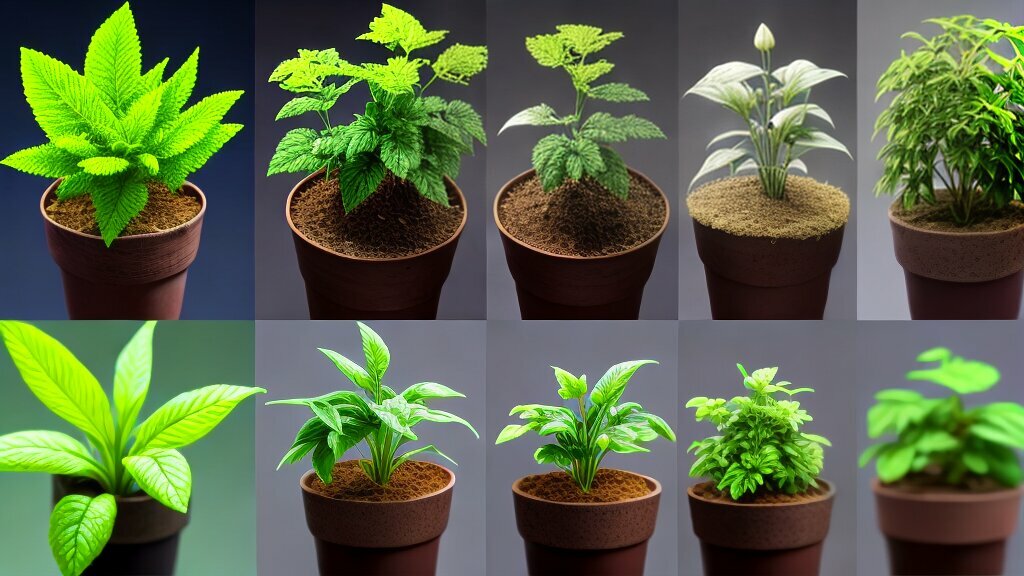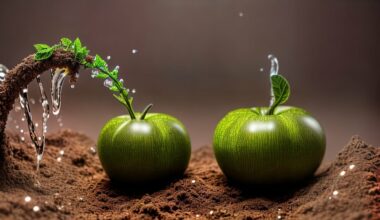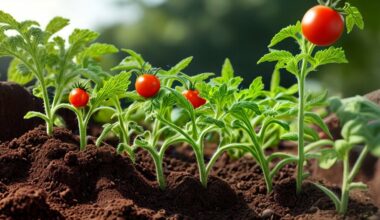Have you ever wondered how plants grow from tiny seeds into towering trees or lush fields of crops? The process of plant growth is a complex and fascinating one, influenced by a variety of environmental and biological factors. Understanding what causes plants to grow can help you become a better gardener, farmer, or even just appreciate the natural world around you.
Image source:
Key Takeaways:
- Plant growth is influenced by a variety of environmental and biological factors.
- The process of plant growth involves several stages, from seed germination to maturity.
- Plant growth hormones, photosynthesis, and nutrient availability all play important roles in plant growth and development.
Plant Growth Factors: The Key Drivers
Plants require specific environmental conditions to thrive. The factors that impact plant growth are critical to their success. These factors are responsible for the variability in plant growth and development.
The environmental factors affecting plant growth include light, water, temperature, and soil. Light is vital to photosynthesis, which produces energy for plant growth and development. Without an adequate supply of water, plants cannot absorb nutrients from the soil, and their growth is stunted. The temperature of the environment also affects plant growth, as some plants can only grow in specific temperature ranges. The type of soil present also significantly impacts plant growth and development, as it determines the nutrients available to the plant.
In addition to environmental factors, there are other key drivers of plant growth. For example, the presence of plant growth factors is essential to successful plant growth and development. Plant growth factors are chemical compounds that regulate various aspects of plant growth, such as cell division and elongation. These factors include auxins, cytokinins, gibberellins, abscisic acid, and ethylene.
| Plant Growth Factors | Function |
|---|---|
| Auxins | Stimulate cell elongation and division, promote root growth |
| Cytokinins | Promote cell division, delay senescence |
| Gibberellins | Stimulate stem elongation, promote seed germination |
| Abscisic acid | Regulate seed dormancy, control stomatal opening and closing |
| Ethylene | Regulate fruit ripening, promote abscission, and senescence |
Understanding the key drivers of plant growth is essential to the successful cultivation of plants. By creating optimal environmental conditions and providing adequate plant growth factors, you can promote healthy plant growth and development.

Plant Growth Requirements: What Plants Need
Just like humans, plants also have certain requirements for survival and growth. Providing the right conditions for your plants is essential to ensure their health and vitality. These requirements involve plant nutrition, sunlight, water, air, and soil. Each of these elements plays a critical role in determining the growth and development of your plants.
Plant Nutrition
Plant nutrition is essential for proper growth and development. The three major macronutrients required by plants are nitrogen, phosphorus, and potassium. Plants also need secondary macronutrients such as calcium, magnesium, and sulfur. Micronutrients like zinc, iron, and copper are also necessary for plant growth. A healthy soil composition with proper nutrients can ensure the overall growth and yield of your plants.
| Nutrient | Function | Deficiency symptoms |
|---|---|---|
| Nitrogen | Part of chlorophyll for photosynthesis | Yellowing of leaves |
| Phosphorus | Important for root and stem growth | Purple leaves |
| Potassium | Regulates water uptake | Wilting, yellowing leaves |

Image source: seowriting.ai
A lack of nutrients can lead to a stunted growth and disease in plants. Thus, it is important to provide your plants with the necessary nutrients to ensure their optimal growth.
Unveiling the Plant Growth Stages
Plants go through multiple growth stages during their lifespan. Understanding these stages can help you provide the best care for your plants, leading to healthy growth and development.
The first stage is the germination stage, where the seed begins to sprout and grow roots. This stage is critical, as it sets the foundation for the entire plant’s growth and development.
Next, plants move into the vegetative stage, where they focus on leaf and stem growth. During this stage, it’s crucial to provide your plants with plenty of light and nutrients to support healthy growth.
| Growth Stage | Length | Description |
|---|---|---|
| Germination | Varies by Species | The seed begins to sprout and grow roots. |
| Vegetative | 4-6 Weeks | Focus on leaf and stem growth. |
| Flowering | 2-16 Weeks | Plants develop flowers and begin to produce fruit or seeds. |
| Ripening | Varies by Species | Fruit or seeds mature and are ready for harvest. |
The flowering stage comes next, where plants begin to develop flowers and produce fruit or seeds. This stage can last anywhere from 2 to 16 weeks, depending on the species of plant.
Finally, plants move into the ripening stage, where their fruit or seeds mature and are ready for harvest. It’s essential to pay close attention during this stage and harvest your plants at the appropriate time to ensure the best flavor and quality.

The Role of Plant Growth Hormones
In addition to environmental factors and nutrients, plant growth hormones also play a crucial role in the growth and development of plants. These hormones are naturally occurring chemicals that regulate a variety of plant processes, including cell division, elongation, and differentiation.
There are five main types of plant hormones: auxins, cytokinins, gibberellins, abscisic acid, and ethylene. Each hormone has a unique function in the growth and development of plants. For example, auxins are responsible for cell elongation and differentiation, while cytokinins stimulate cell division.
Gibberellins, on the other hand, promote stem elongation and fruit growth, while abscisic acid regulates the plant’s response to stress and environmental factors such as drought. Ethylene is involved in the ripening of fruits and the senescence of flowers and leaves.
The balance of these hormones is critical to plant growth and development. For example, too much auxin can cause plants to become elongated and spindly, while too little can result in stunted growth. Similarly, an imbalance of cytokinins can result in abnormal growth patterns.
Researchers are continuing to investigate the complex interactions between plant hormones and environmental factors, in order to further understand and optimize plant growth and development.

Image source: seowriting.ai
The Power of Photosynthesis
Photosynthesis is the process by which plants convert light energy into chemical energy, which is then stored in the form of glucose and other organic compounds. In other words, photosynthesis is the key process that is responsible for the growth of plants.
Photosynthesis occurs in the chloroplasts of plant cells. Within the chloroplasts, there are chlorophyll pigments that absorb light energy from the sun. This energy is then used to split water molecules into oxygen and hydrogen ions. The oxygen is released back into the atmosphere as a byproduct, while the hydrogen ions are used to create energy-rich compounds like ATP.
Carbon dioxide from the atmosphere is also taken in by plants during photosynthesis. This gas, along with the energy from the ATP molecules, is used to produce glucose and other organic compounds that are necessary for the growth and survival of plants.

Photosynthesis is important not only for the growth of plants but also for the production of oxygen in the atmosphere. Without photosynthesis, the air we breathe would be vastly different, and life as we know it would not be possible.
Understanding how photosynthesis works is crucial for farmers, gardeners, and anyone who wants to grow healthy and strong plants. By providing the right amount of light, water, and nutrients, you can ensure that your plants are able to carry out photosynthesis efficiently and produce the energy they need to grow and thrive.
Factors Affecting Plant Growth
Plant growth is influenced by various factors which can be categorized into internal and external factors. Understanding what these factors are and how they affect plant growth can help you optimize your garden or farm. Here are some of the factors that affect plant growth:
- Light: Light is one of the primary factors that affects plant growth. It is necessary for the process of photosynthesis, which is how plants produce energy. Plants need different amounts and spectrums of light at various growth stages. For instance, seedlings require more blue light, while flowering plants need more red light.
- Water: Just like light, water is also essential for photosynthesis. It acts as a transport medium for nutrients and helps maintain the turgidity of plant cells. Lack of water can cause plants to wilt and eventually die. Overwatering, on the other hand, can lead to oxygen deprivation in the soil, which can be harmful to plant roots.
- Nutrients: Plants require a range of nutrients to grow. The primary macronutrients that plants need include nitrogen, phosphorus, and potassium. They also require secondary macronutrients like calcium, magnesium, and sulfur, as well as micronutrients like boron, iron, and zinc. Lack of nutrients can lead to stunted or yellowing plants.
- Soil: The type and quality of soil can have a big impact on plant growth. Sandy soils can drain too quickly, leaving plants without enough water, while clay soils can be too compacted, making it hard for roots to grow. The ideal soil for plant growth is nutrient-rich, well-draining, and with a pH level suitable for the plants you are growing.
- Temperature: Temperature affects plant growth in many ways. Most plants thrive within a specific temperature range. Extreme temperatures can stress or damage plants. For instance, frost can damage tender new growth, while heatwaves can cause plants to wilt or even die.
- Humidity: Humidity is the amount of water vapor in the air. High humidity can be beneficial for some plants, while low humidity can cause them to dry out. Plants grown in dry environments will need more frequent watering.
- Air: Plants require good air circulation to thrive. Stagnant air can lead to pests and diseases, while too much wind can damage plants.

Remember that these factors are interdependent. A lack of one factor can affect plant growth, even if all the other factors are optimal. Therefore, it is essential to provide plants with the right growing conditions for them to thrive.
Conclusion
You now have a better understanding of what causes plants to grow and the factors that influence their growth. From the key drivers of plant growth to the plant growth stages and the role of plant growth hormones, there are many factors that contribute to the growth and development of plants.
Plant nutrition is also an essential factor in plant growth, and ensuring that your plants receive the necessary nutrients is crucial to their well-being. The power of photosynthesis cannot be understated, as it is the process by which plants convert sunlight into energy.
Environmental conditions, such as the amount of water and light, as well as the temperature and soil quality, can also affect plant growth. It is important to understand these factors and how they impact your plants in order to provide a conducive environment for their growth.
With this knowledge, you can take better care of your plants and ensure they receive the best possible conditions for their growth. So go ahead and nurture your green thumb, and watch your plants thrive and flourish!





